
Super vivid fluorite & quartz specimen
Quinglong mine, China
#quartz #fluorite #quinglongmine #china #minerals #mineralspecimen #mineralogy #geology #gem #gemology #gemologicalspecimen
@patrickkapty.bsky.social
Author, historian, curator, reseller - I sell wearable and other art, and I am fascinated by cultures and artifacts from around the world! My shop is: California Dreaming Art Jewelry Etc: https://www.rubylane.com/shop/california-dreamin-art-jewelry-etc

Super vivid fluorite & quartz specimen
Quinglong mine, China
#quartz #fluorite #quinglongmine #china #minerals #mineralspecimen #mineralogy #geology #gem #gemology #gemologicalspecimen

A huge vintage 1960s 70s one of a kind handmade mixed metals (copper, brass) and heavily patinated abstract modernist design cuff bracelet by studio jeweler Lascaux from Quebec, Canada. Entirely handmade no doubt one of a kind creation by a talented designer and craftsman! The copper has a zig zag line of brass/bronze laid overtop, and the copper has been heavily patinated in various colors, and with gold and silver spiderweb lace-like designs in spots! Really quite complex design exquisitely handmade! Measures 2" wide and fits up to a 7" wrist presently, although it could be easily adjusted up a few sizes if desired. Marked at one end, "Lascaux" for the artisan-jeweler from Quebec. There is one spot on the bracelet where the design has cut-thru in a ragged sort of opening. This is original, not damage, and I'm guessing part of the original design (see my closeup photos). A spectacular one of a kind piece of vintage wearable art! Excellent vintage condition.
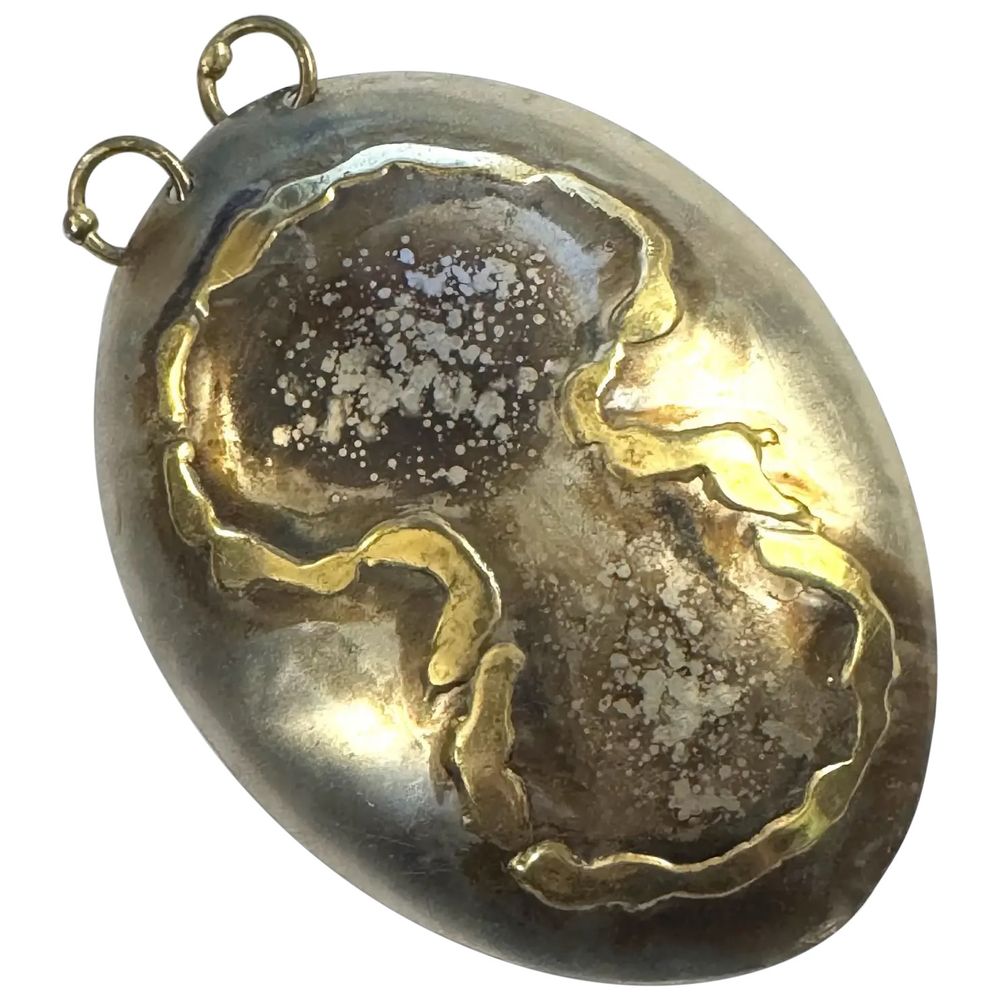
A very large vintage 1960s 70s one of a kind handmade mixed metals (brass, steel) heavily patinated abstract modernist brutalist pendant by studio jeweler Lascaux from Quebec, Canada. Entirely handmade no doubt one of a kind creation by a talented designer and craftsman! An overall dimensional oval shape that rises outward in steel with an applied figure 8 or infinity symbol inside of which is a splattered-looking brown patina reminiscent of abstract expressionist artworks. Two bronze hoops at top for adding a chain or neckring or a cord! Measures 3.5" tall by 2.5" wide. The hoops at top will accommodate a good-sized chain or neckring up to about 1/4" wide, or just about any fabric cord you like. Marked at back, "Lascaux" for the artisan-jeweler from Quebec. A spectacular one of a kind piece of vintage wearable art! I can provide a fabric cord free of charge if you need one, just let me know when you're making the purchase. Excellent vintage condition.
Two vintage 1960s Lascaux Quebec mixed metal pieces, a very large bracelet, and an equally impressive pendant.
Available...
www.rubylane.com/ni/shop/cali...
#lascaux #quebec #canada #handmade #mixedmetal #bracelet #pendant #vintage1960s #vintage1970s #vintagemodern #wearableart #oneofakind #art
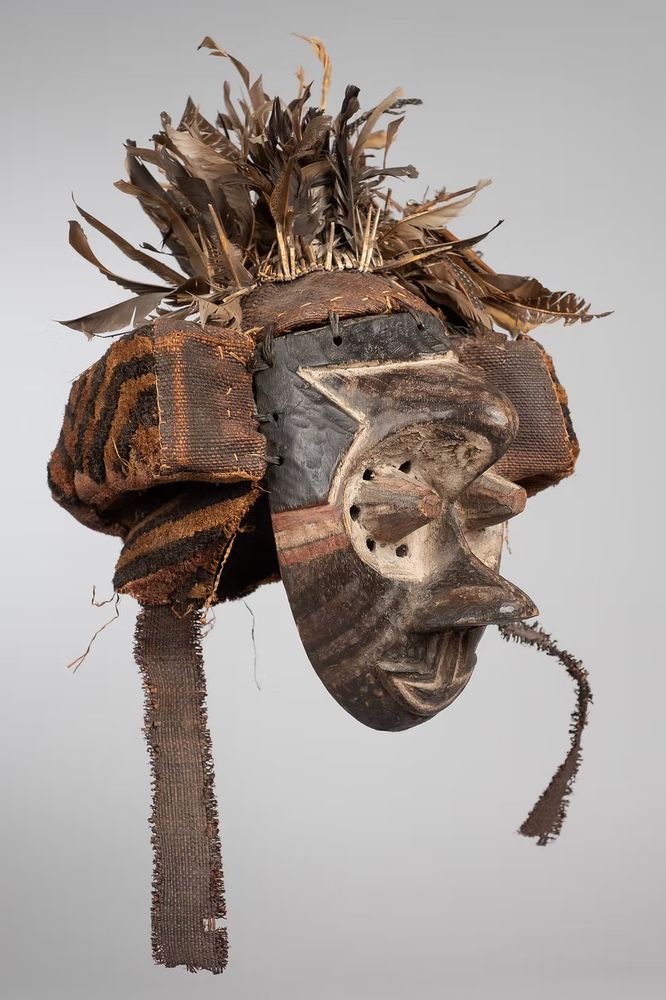
The Kuba Kingdom, also known as the Kingdom of the Bakuba or Bushongo, is a traditional kingdom in Central Africa. The Kuba Kingdom flourished between the 17th and 19th centuries in the region bordered by the Sankuru, Lulua, and Kasai rivers in the heart of the modern-day Democratic Republic of the Congo. This mask may have represented a wise older man at boys’ initiations. One of the principal Kuba dance masks is called pwoom itok. The chief identifying characteristic is the shape of the eyes, whose centers are cones surrounded by holes through which the wearer sees. Like many Kuba types of masks, pwoom itok is extensively polychromed, or multicolored, and in this case adorned with many feathers at top.
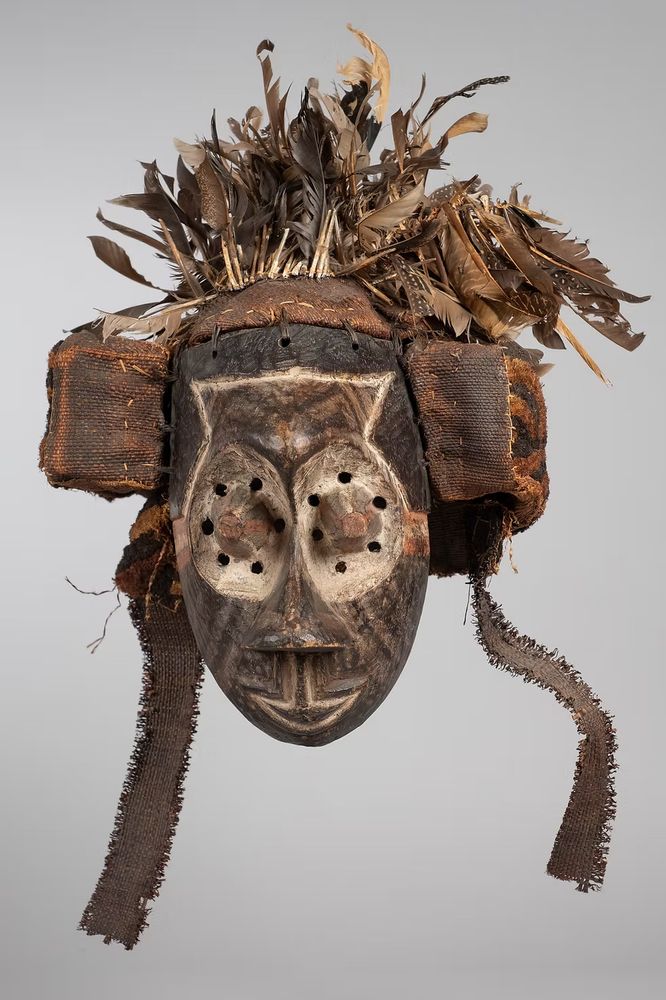
Kuba mask
(pwoom itok)
Democratic Republic of the Congo
#kuba #mask #handmade #carved #wood #polychrome #feathers #pwoomitok #initiation #ritual #religion #africanart #tribalart #congo #DRC #tribalmask #africanmask

Paul Klee’s artistic skills were diverse: he was a painter, printmaker, critic, and theoretician. He taught at the Bauhaus for most of the famed school’s existence; initially head of the bookbinding department, he also supervised the glass-painting workshop. His greatest influence, however, was as a lecturer for the basic design course on the theory of form in art. In lectures, Klee developed his ideas about the “polyphony” of painting, which was based on his interest in simultaneous sensational effects that could be created by various layered formal elements. He believed that this type of creative experimentation could “issue forth a transformed beholder of art” and thus pave the way for total abstraction.
Fleeing Ghost
1929
Paul Klee
German, born Switzerland, 1879–1940
#paulklee #fleeingghost #bauhaus #germanart #modernism #modernart #art #dated1929

A huge one of a kind vintage 1950s handmade sterling silver copper enamel modernist pendant on cord necklace by San Diego artist/craftsman Barney Reid (1913-1992). A very large quite rare and outstanding example of the modernist enamel art created by this important California artist from the mid 20th century! Truly wearable art! A founding member of San Diego’s Allied Craftsmen, Reid was a talented artisan and prolific in many media including metal, clay, wood, and marble, as well as oil painting and furniture design. A selection was featured in several shows in the 1950s and 60s at New York City’s Museum of Contemporary Crafts, including Enamels in 1959. Reid's work was prominently displayed in the exhibition "San Diego Craft Revolution" at the Mingei Museum in San Diego in 2012. One of Reid's larger works, a multipanel enamel mobile, sold at Christie's in 2016 for over $32K before auction fees and taxes! Pendant measures 3-1/2" by 2-3/4" wide on a 26" length leather cord that can be re-tied at varying lengths, and weighs 37.2 grams total. Marked at back with artist signature as shown. Excellent vintage condition.
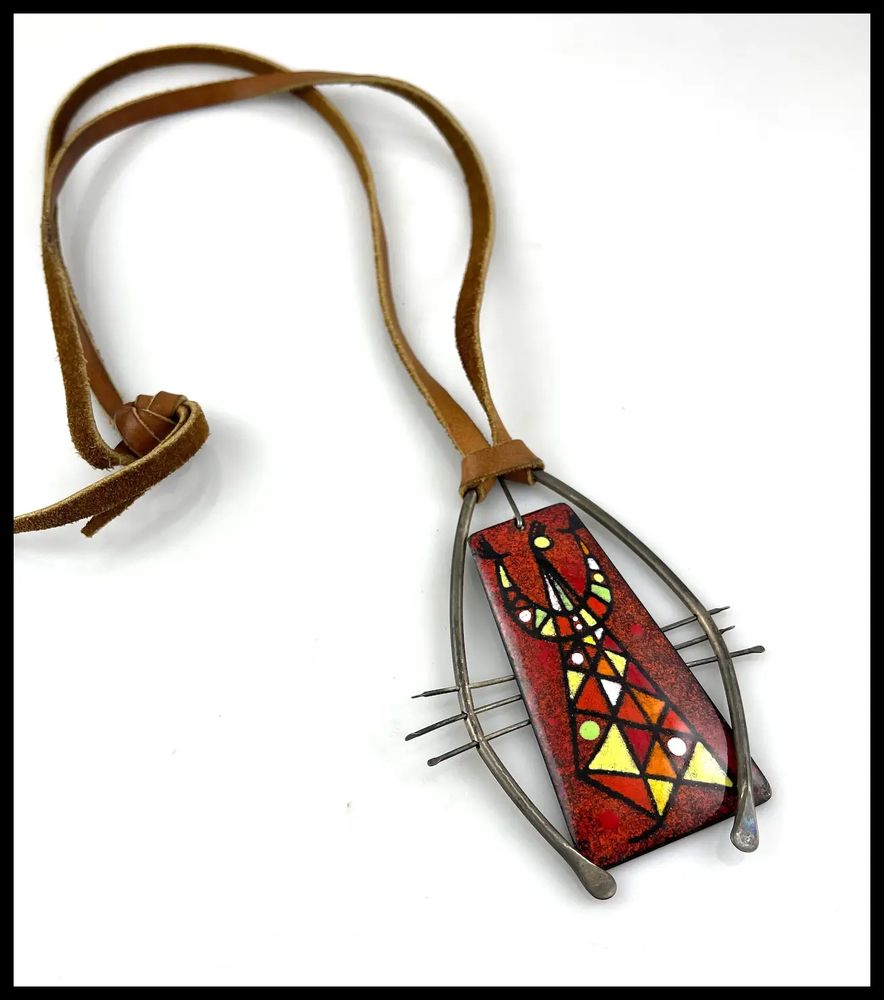
Here is a short biography of the artist that I compiled from online sources: Barney Reid grew up in Yuma Valley, Arizona earning his BA at Arizona State College. He moved to San Diego to work as a graphic designer after teaching at Arizona State University (between 1946-49) and launched ReidArt offering screen-printed fabrics and textiles. Barney Reid’s jewelry was exhibited nationally in the 1950s and '60s and for a time he shared a studio with Harry Bertoia. Reid’s enamels were featured in several prominent exhibitions throughout the country including the prestigious annual Decorative Arts and Ceramics Exhibition at the Wichita Art Association in 1952, 1953 and 1954; Enamel: An Historic Survey to the Present Day, organized by the Cooper Union Museum for the Arts of Decoration in 1954; the seminal Enamels at New York’s Museum of Contemporary Crafts in 1959; and the Scripps Annual in Claremont, California in 1964. One of Reid’s most inventive works – an abstraction in which small enamel panels were mounted on a horizontal wood panel in a lively, interlocking composition – was featured in a 1957 article in Craft Horizons – the forerunner to American Craft – in an article titled 'Plaque Bouillabaisse'. Reid’s works from the late ‘40s through the ‘60s are quite scarce. By the mid-1970s until his death he worked almost exclusively in intaglio printmaking.
A copper enamel and sterling silver pendant on the original leather cord by San Diego artist/designer Barney Reid circa 1950s.
Available...
www.rubylane.com/item/1879775...
#barneyreid #sandiego #californiadesign #modernistjewelry #copperenamel #enamelart #art #oneofakind #handmade #wearableart

Man Ray (1890-1976), peintre, photographe et réalisateur américain naturalisé français.
#photographie
#ManRay

Hair Pursued by 2 Planets
Hair Pursued by 2 Planets https://www.wikiart.org/en/joan-miro/hair-pursued-by-2-planets
02.08.2025 08:41 — 👍 9 🔁 1 💬 0 📌 0
Audrey Hepburn, 1956 - Allan Grant (1919-2008), photojournaliste. Il a réalisé la dernière séance photo avec l'actrice Marilyn Monroe et a pris les premières photos de Marina Oswald, l'épouse de Lee Harvey Oswald, après l'assassinat de John F. Kennedy.
#photographie
#AllanGrant
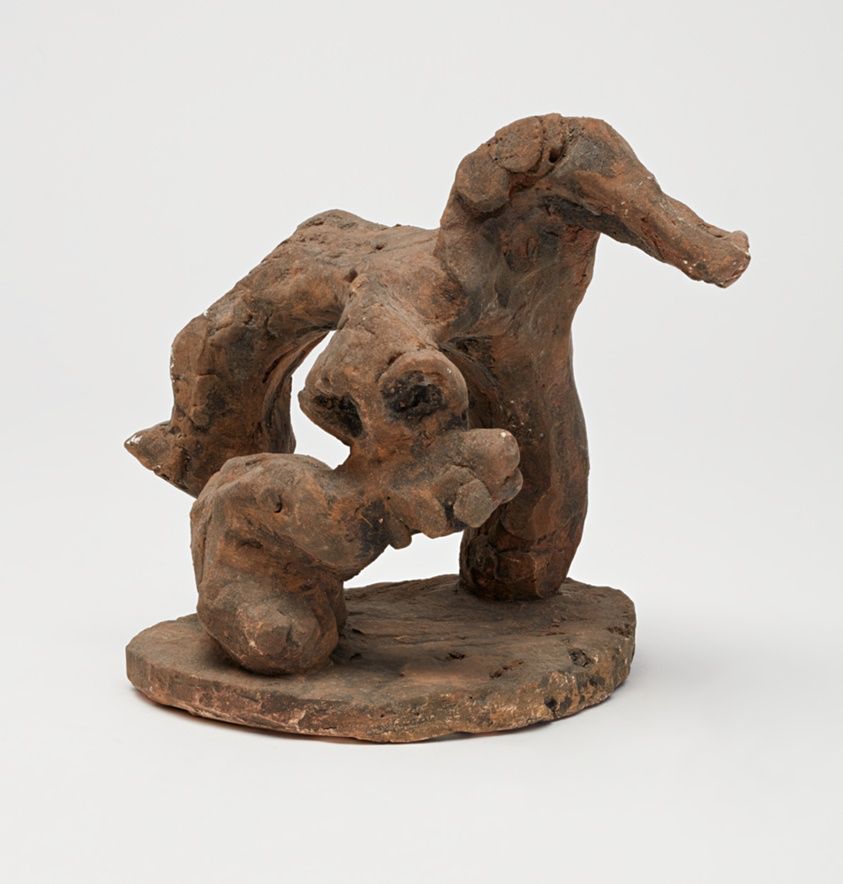
plaster sculpture by Jacques Lipchitz Kosme María de Barañano, Jacques Lipchitz: The Plasters, a Catalogue Raisonné, 1911–1973 (Bilbao: BBK, Fundación Bilbao Bizkaia Kutxa, 2009), no. 258. Donated by the artist; the Jacques and Yulla Lipchitz Foundation, New York; given to the Art Institute of Chicago, 2019.
'Pastoral' sculpture
plaster
1942
Jacques Lipchitz
French and American, born Lithuania (1891-1973)
#art #modernart #sculpture #jacqueslipchitz #pastoral #dated1942 #modernsculpture #20thcenturyart #frenchmodernism
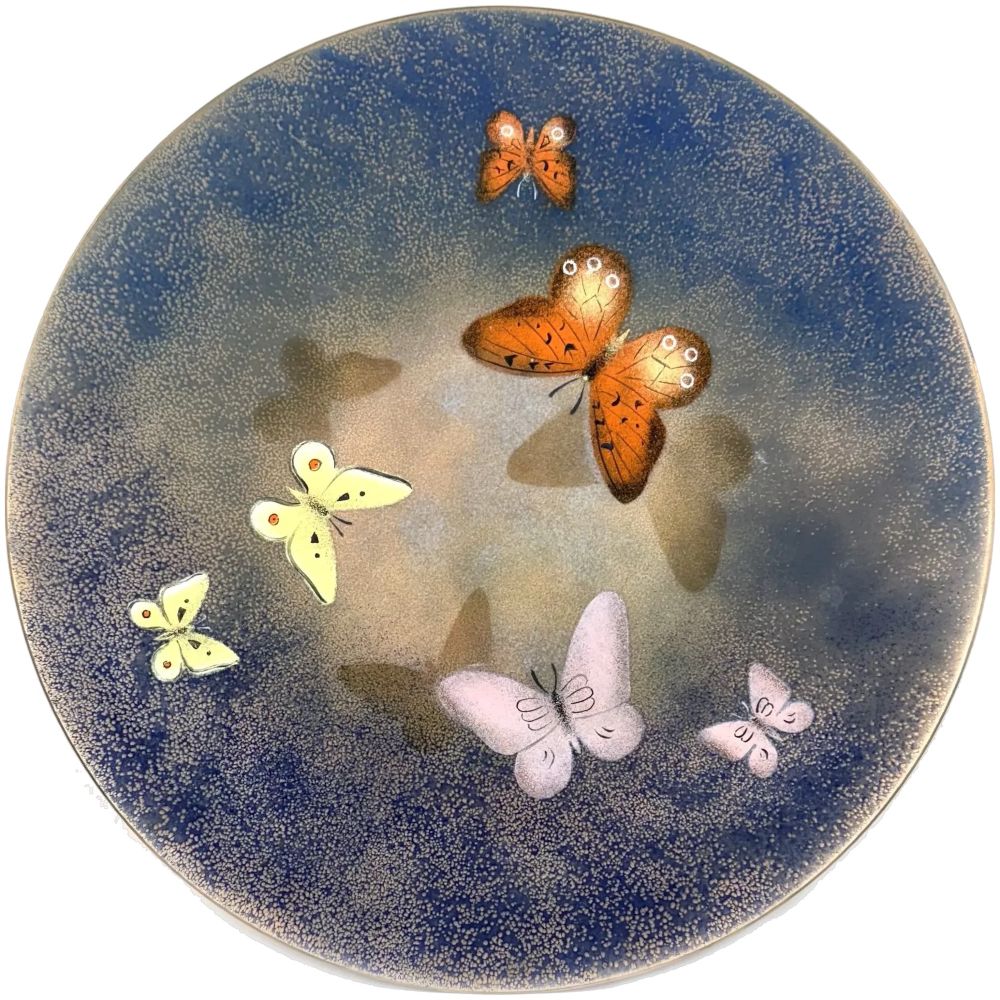
A huge vintage 1950s handmade multicolored copper enamel 'Butterflies are Free' enamel artwork by California artist Lily Alexander. The largest version of her 'butterflies' themed enamel artworks, and in pristine almost like-new condition! The design consists of three larger and three smaller butterflies circling the center, and their shadows underneath them against a mottled background that graduates from a mottled blue at the outer edges to a pinky-copper at center. One of Alexanders more feminine designs, though she obviously loved animals of all kinds as she so often depicted them in her work! She often associated her designs with popular movies of the time. I had another of hers titled "King of Siam" which depicted a regal Siamese cat. I am calling this one, "Butterflies are Free", though the romantic movie no doubt came after this artwork, but it seems an apt title. Lily Alexander was of Scottish/Japanese origin, and was the artistic half of the husband and wife team that included her and her husband, Paul Alexander. He was the marketing mind that ran the business while his wife handled all the design work and actual crafting of the pieces. They seem to have been primarily active during the 1950s and 60s. The tray measures 12" diameter by about 1" high at the rim. Has a hanging apparatus attached at back as shown, and marked "Hand Crafted in California by Alexander" as shown. There is also an intact sticker at back with a number, "713", perhaps a gallery note. In excellent vintage condition.
A large vintage 1950s handmade copper enamel Butterflies and their Shadows design artwork by Scottish/Japanese/American artist, Lily Alexander of California.
Available...
www.rubylane.com/item/1879775...
#butterflies #lilyalexander #copperenamel #art #artwork #enamelart #handmade #vintage1950s
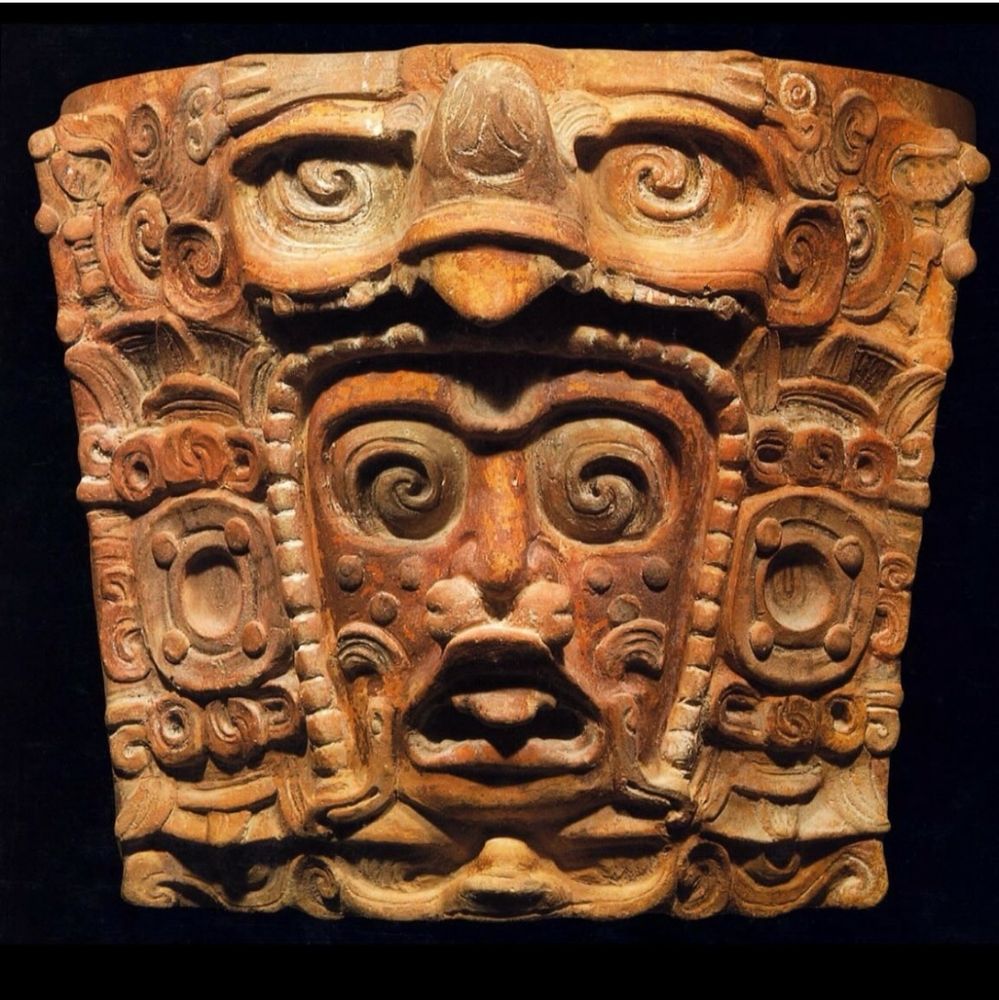
Mayan urn
ceramic
550-900 CE
#Maya #mayan #precolumbian #prehispanic #mesoamerica #mexico #handmade #ceramic #urn #ancestorworship #ritual #religion
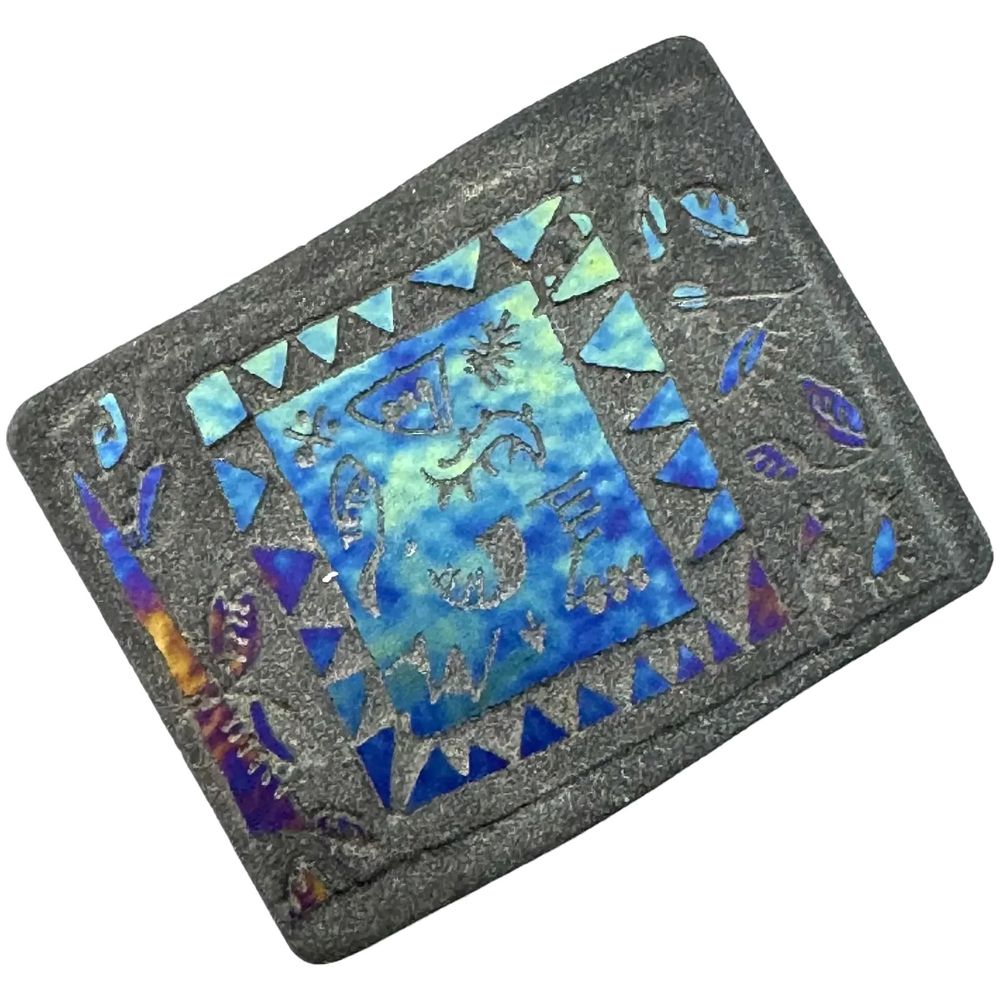
A unique vintage 1970s one of a kind handmade titanium on pottery Tribal modernist figures design brooch. The image at front is revealed when the angle of the light reaches a certain angle, and the figures look like ancient pictographs perhaps inspired by the famous Lascaux cave drawings. Looks like the titanium coating was cut-thru at front to reveal the black pottery base. Very unusual, never seen another! Measures 2" wide by 1-5/8" tall at front. Unmarked, and I'm guessing was originally sold through an art gallery or fair with accompanying paperwork or labeling that has been lost over the years. No doubt a one of a kind piece of wearable art! Excellent vintage condition.
An anonymous oddity - handmade vintage 1970s ceramic brooch with applied titanium tribal prehistoric modernist design at front!
Available...
www.rubylane.com/item/1879775...
#brooch #handmade #ceramicjewelry #tribal #prehistoric #lascaux #cavedrawings #design #wearableart #art
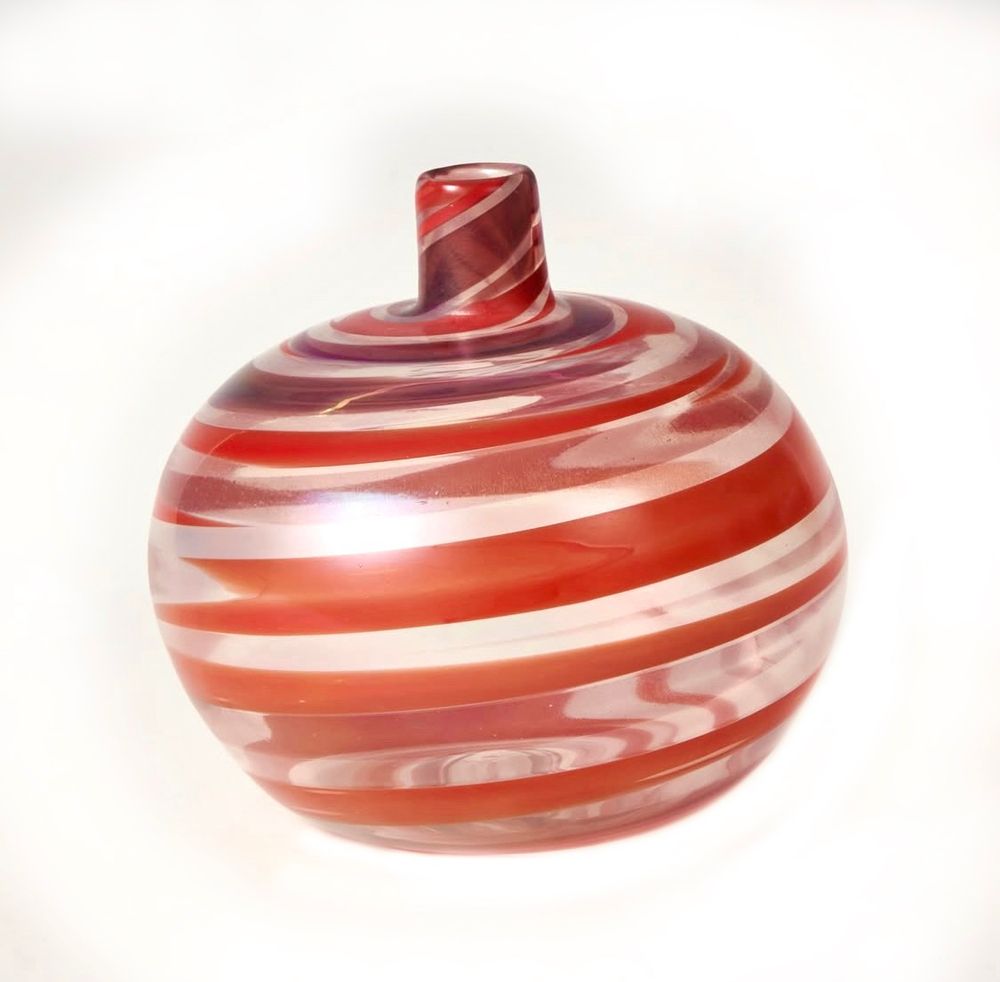
Pennellate vase
1942
Venini
Murano, Italy
Carlo Scarpa design
#venini #pennellate #glass #artglass #muranoglass #italianglass #modernglass #mcm #handmade #art #carloscarpa #vase
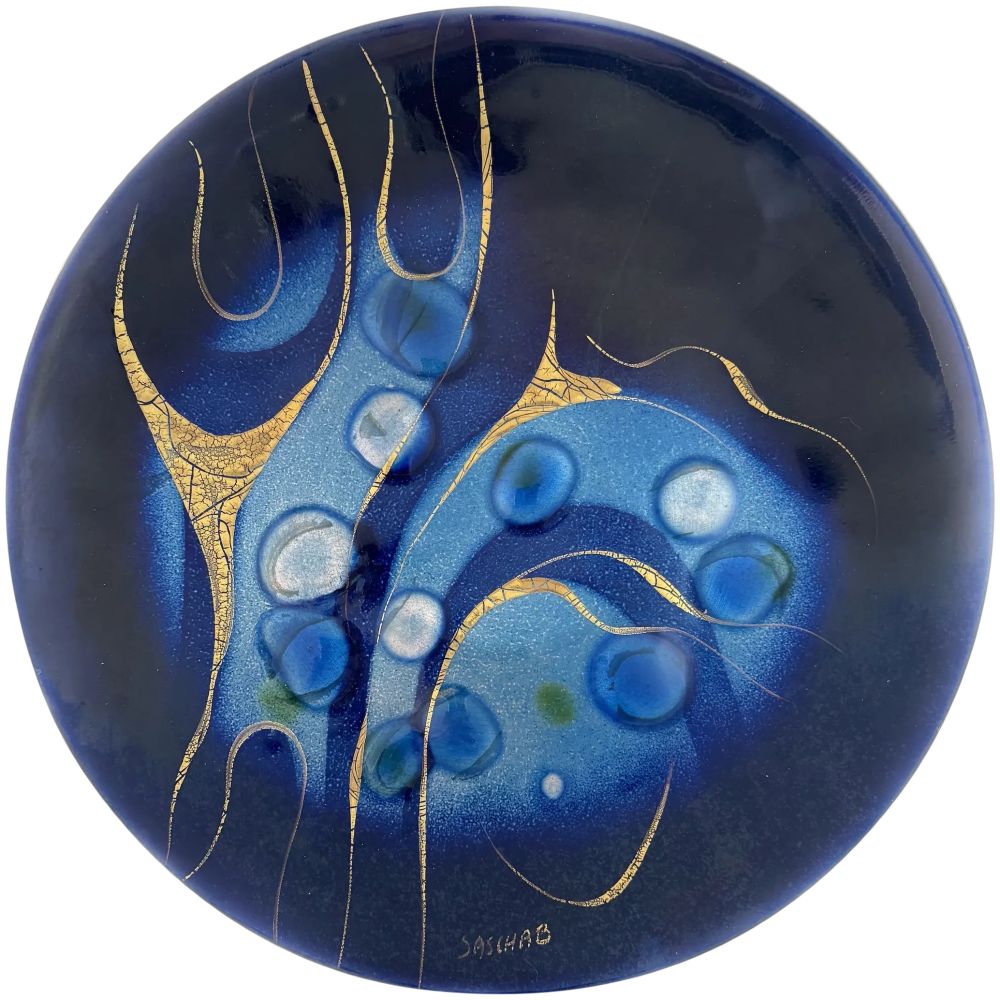
A flawless vintage 1950s handmade blues and gold copper enamel abstract modernist tray artwork by California multi-disciplinary artist/designer Sascha Brastoff (1917-1993). An incredible one of a kind work of abstract art in shades of blue and white with gold painted overtop the enamel! An exceptionally large example, and in flawless original condition! His work is getting harder and harder to find especially in the larger formats like this one! Measures 11.75" diameter by 1.75" high at rim when placed flat, and weighs over 2 pounds prior to packing. Signed at front as shown, "Sascha B." and has a number at back that is likely the design number. Brastoff designed these enamel artworks, but had professional enamelists make them for him to his specifications. This was the case with the bulk of his pieces as his designs crossed into so many different arts and crafts. As these enamel artworks were handmade, they are each unique with small differences in the execution of the design. See my last two photos for an image of the artist as a young man, and a short biography of him that I found online. There is an original hanging apparatus at back as shown. This is an enamel artwork, not a catch-all on a table where you throw your keys and coins. Enamel is quite fragile, and I suggest preserving it by displaying it on your wall or in a case. Excellent vintage condition.
A flawless large vintage 1950s Sascha Brastoff abstract modernist copper enamel artwork - measures 11.75" diameter!
Available...
www.rubylane.com/item/1879775...
#saschabrastoff #californiadesign #californiamodern #abstract #enamel #copperenamel #art #modernart #enamelart #enamelartwork #modern

The Wheel of Life, also known as the Wheel of Existence, one of Tibetan Buddhism's most powerful teaching tools. This artwork shows the cycle of life, death, and rebirth, revealing how our actions shape our realities — both now and in lifetimes to come. At its center are the "three poisons" — attachment, anger, and ignorance - driving the endless loop of suffering. But look closely, and you'll find the Buddha, pointing to the way out.
Wheel of Life,
attributed to Lhadripa Rinzing Chungyalpa, (b.1912, Sikkim - d.1977)
Sikkim
c. 1930
scroll painting, pigments on cloth
Rubin Museum of Himalayan Art
#buddhism #tibetanbuddhism #wheeloflife #sikkim #lhadriparinzingchungyalpa #scrollpainting #cloth #buddhistart #buddhistteachings

Adolph Gottlieb
Blues, 1962
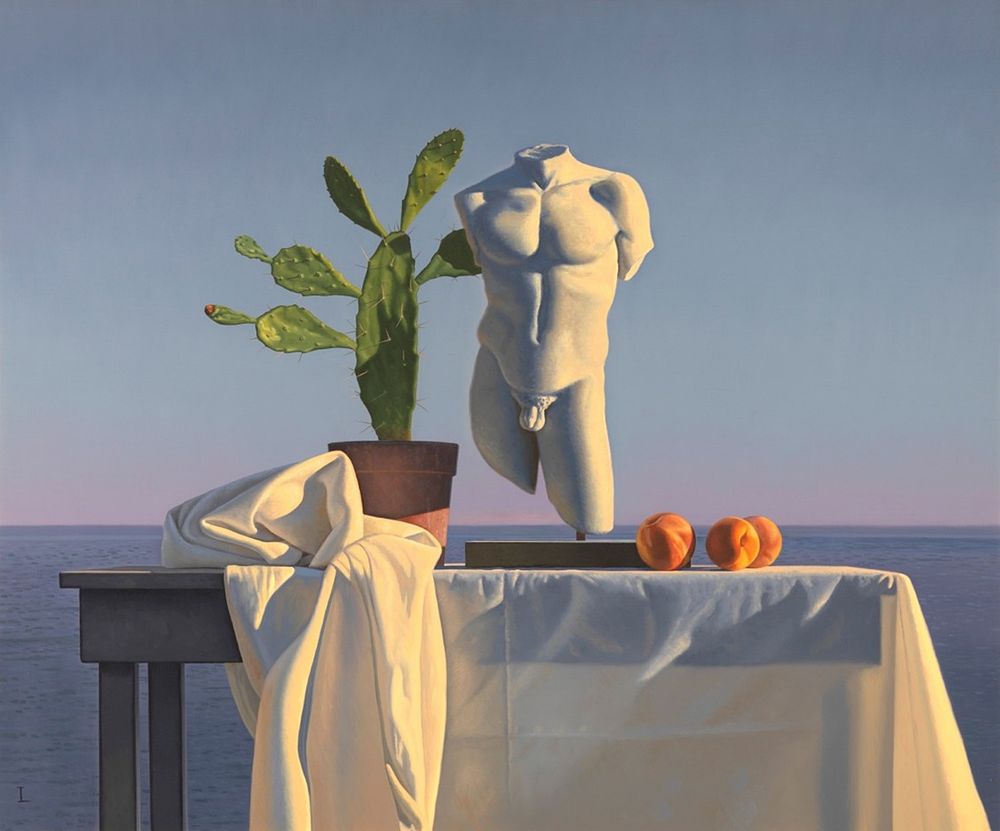
Still Life with Torso and Cactus (c.2001) - David Ligare
01.08.2025 12:19 — 👍 22 🔁 4 💬 0 📌 0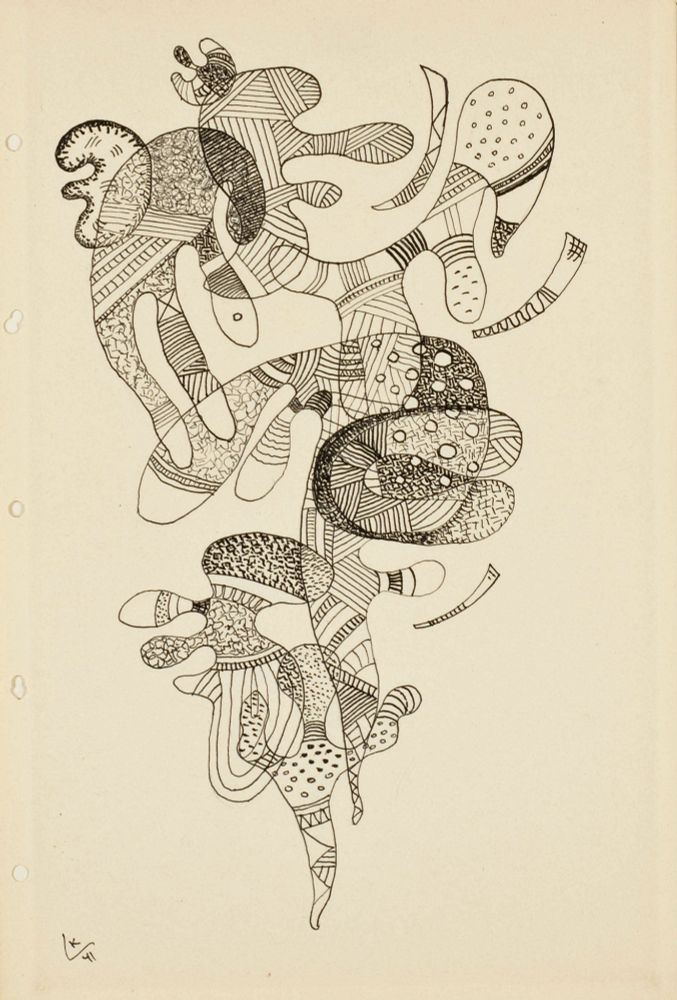
Composition, vers 1941 - Wassily Kandinsky (1866-1944), peintre russe, naturalisé allemand puis français. Il est considéré comme l'un des peintres les plus importants du XXe siècle.
#dessin
#peinture
#WassilyKandinsky

Woman and Bird in the Moonlight
Woman and Bird in the Moonlight https://www.wikiart.org/en/joan-miro/woman-and-bird-in-the-moonlight
31.07.2025 17:39 — 👍 21 🔁 6 💬 1 📌 0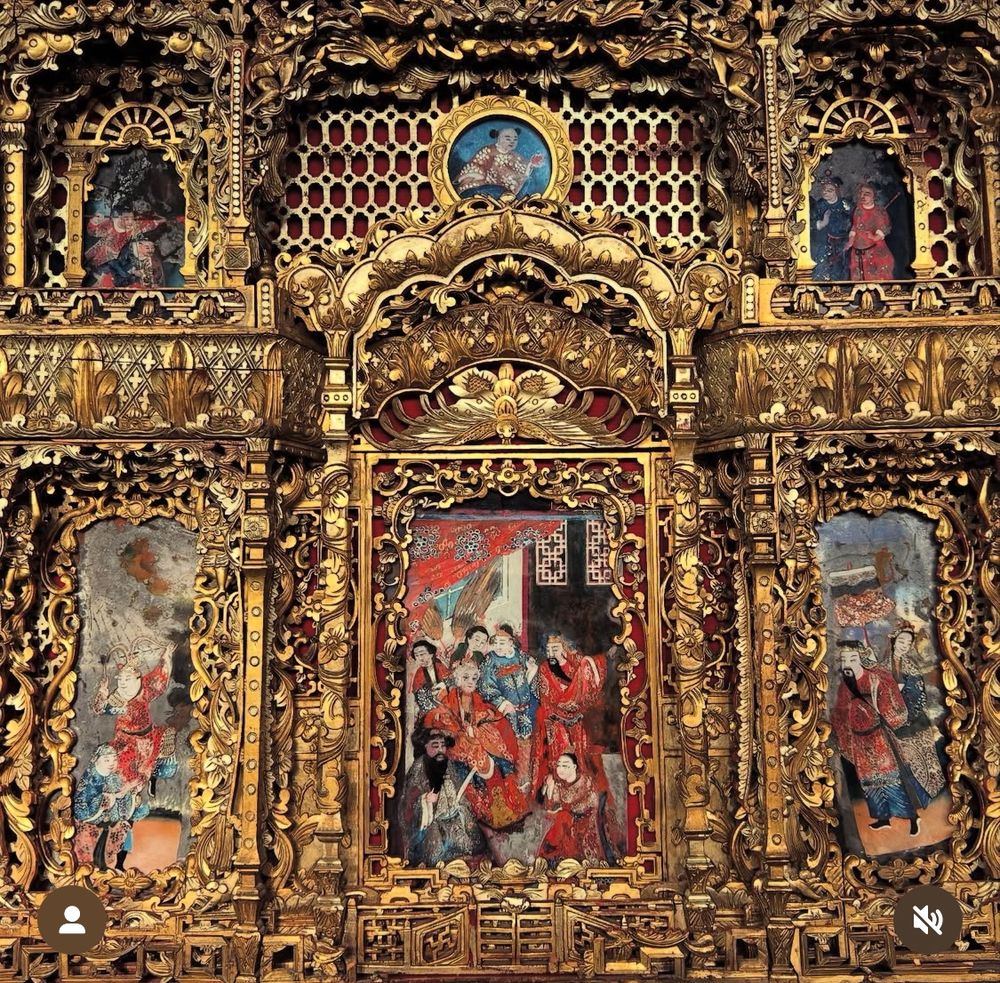

Pair of large Chinese panels
reverse painted glass in carved and pierced gilt wood frames
Qing dynasty (mid 19th century)
China
#china #chinesearts #reversepainted #glass #gilt #wood #frames #qingdynasty #chineseantiques
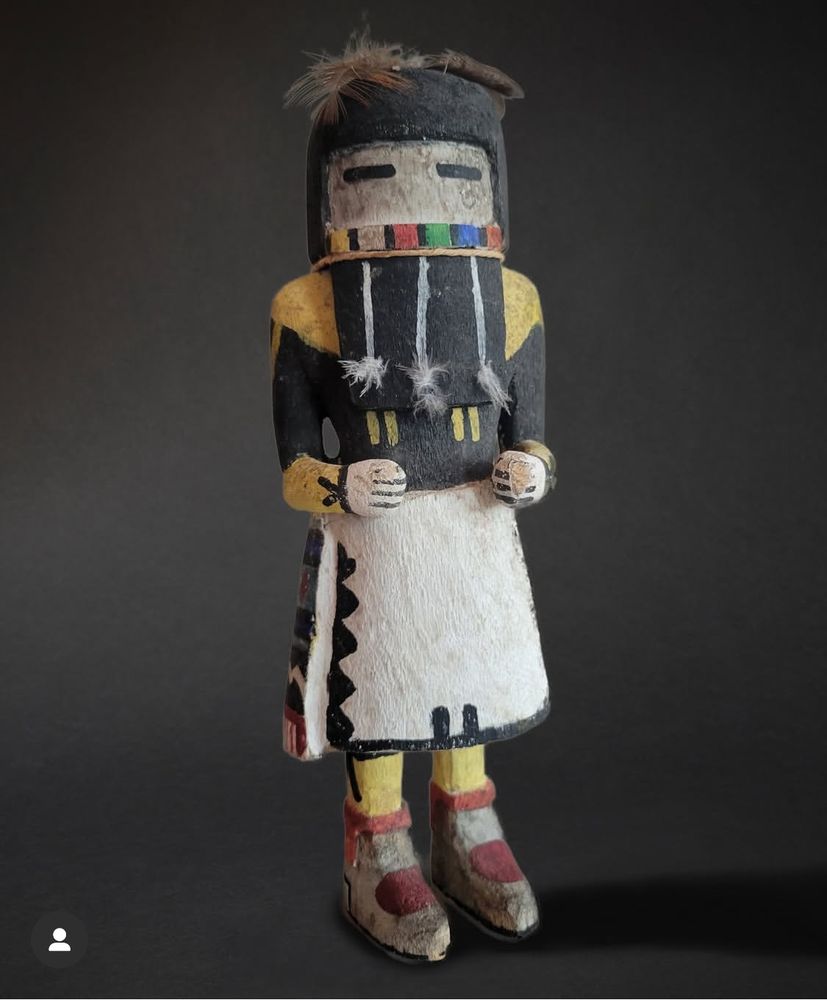
KACHINA DOLL
Angak'Tsina - Long-Hair Katsina doll
Hopi
Arizona, USA
Circa 1930s-40s
Carved wood (cottonwood), feathers and pigments
Height: 24,5 cm
#hopi #kachina #doll #ritual #religion #nativeamerican #handmade #arizona #carved #wood #handmade #feathers #pigment #vintage1930s #vintage1940s
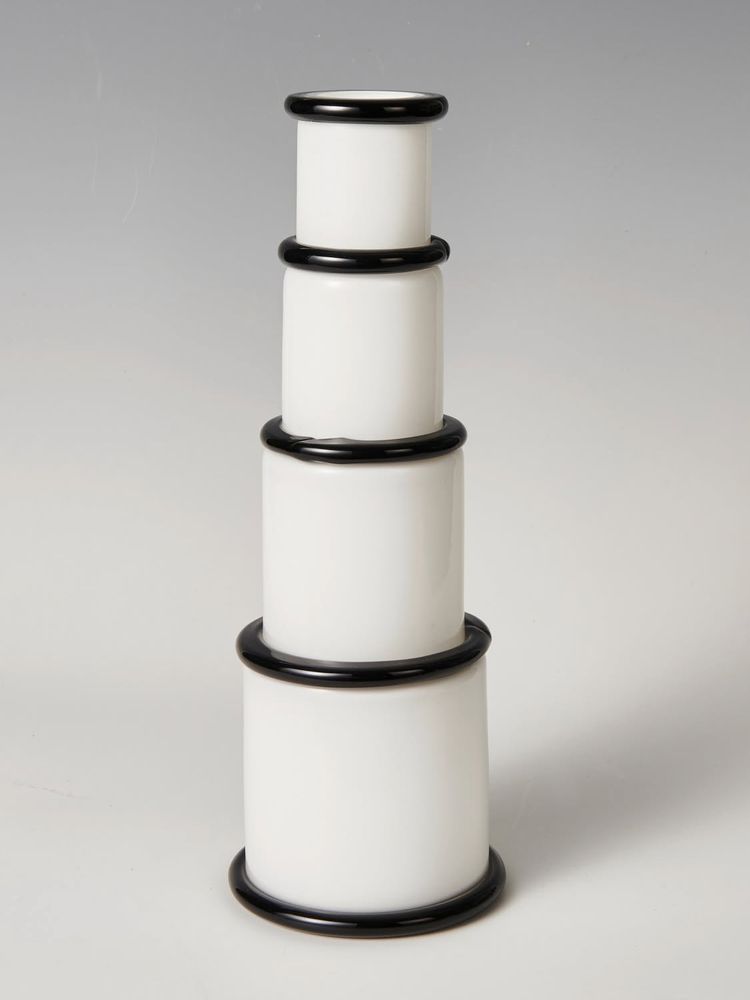
VASE, model 'Morosina', designed 1974 for Vistosi, limited edition of 250. Ettore Sottsass, 'Morosina' vase, 1974, Made by Vetreria Vistosi, Murano. Overlaid glass, colorless and white, attached ribbons made of black glass. Marked: E. SOTTSASS 202/250 Vistosi Barovier / Bischofberger / Carboni, Sottsass Glass works, Stuttgart 1998, p. 16. Number 202 from a limited edition of 250 White and black glass. Signed, inscribed and numbered below: E. SOTTSASS 201/250 VISTOSI.Ø 14 cm; H 39 cm.
'Morosina' sculptural vase
white and black glass
Ettore Sottsass
Vistosi
1974
#ettoresottsass #vistosi #dated1974 #numbered #italy #handmade #italianglass #postmodern #postmodernglass #memphismilano #handmade #sculpture #vase
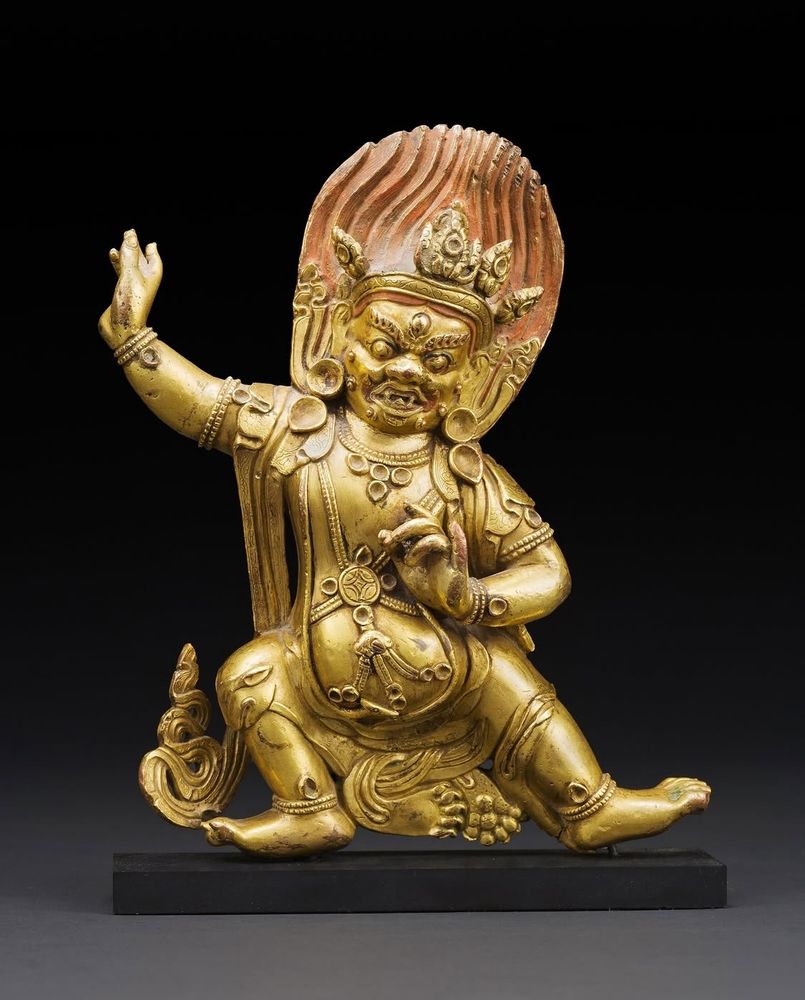
Vajrapani is a powerful bodhisattva in Buddhism, often depicted as a wrathful protector deity, particularly in Tibetan Buddhism. He embodies the Buddha's power and is associated with the vajra, a thunderbolt-like symbol of indestructible wisdom and the force to overcome obstacles. Vajrapani's name translates to "vajra in hand" or "vajra holder," signifying his role as a protector wielding the vajra. The vajra represents clarity of thought, enlightenment, and the ability to cut through delusion. Vajrapani is often depicted in a wrathful form, with a fierce expression, flames, and a powerful physique. However, early Indian depictions show him in a more peaceful form, reflecting his role as a protector. He is a guardian of the Buddha and a protector of the Dharma (Buddhist teachings). He is also seen as a powerful force against negativity and obstacles on the path to enlightenment.
Vajrapani
gilt bronze with polychrome
Tibet
17th century
#vajrapani #tibet #17thcentury #tibetanbuddhism #figure #sculpture #giltbronze #polychrome
#vajra #clarity #cutthrudelusion #protector #buddha #buddhism #dharma #buddhistteachings
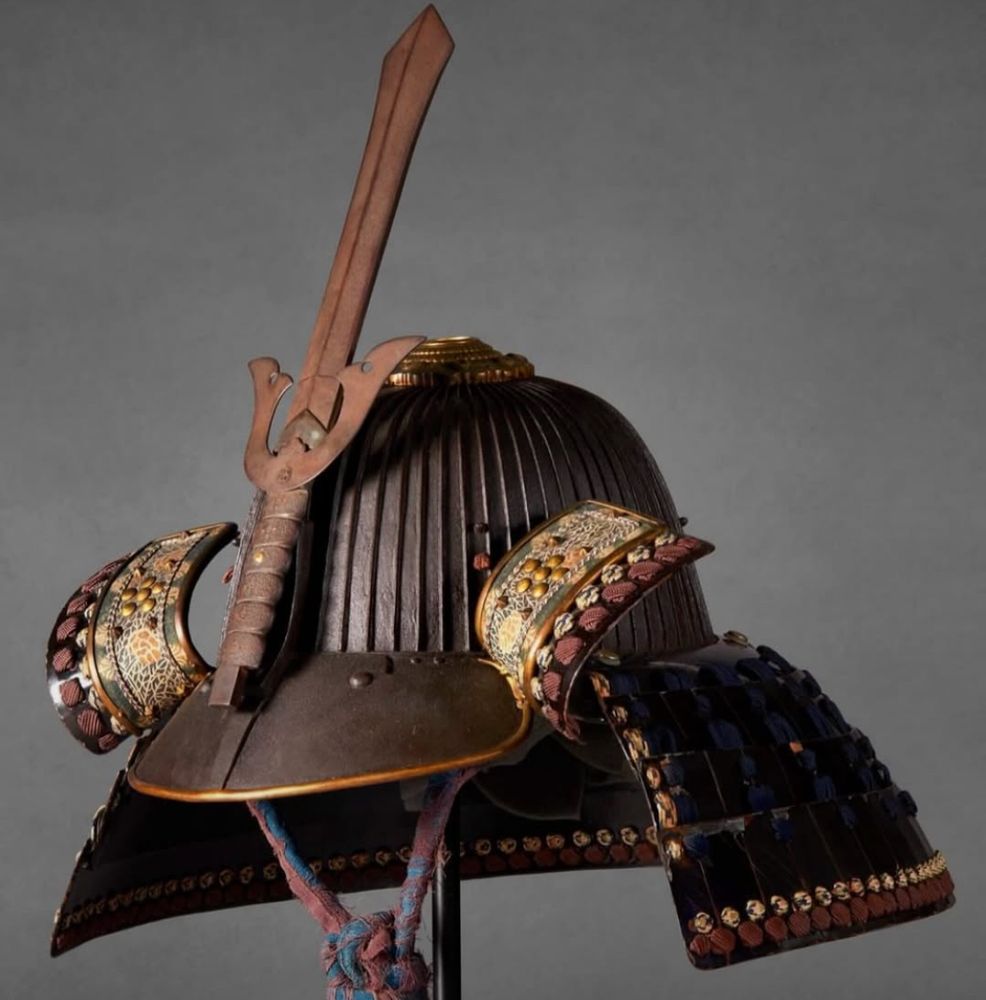
Helmet with vajra sword crest
Japan
17th century
#samurai #helmet #vajra #Japan #japaneseantiques
#17thcentury #antique #art #metalsmithing #metalart #metalcraft #japanesearts

Monochrome photograph featuring a woman, upper half, leaning over a dock to place her hand in the ripples of a river
Frida Kahlo, Xochimilco, Mexico, 1937 #WomensArt
31.07.2025 13:23 — 👍 775 🔁 109 💬 0 📌 4
In 1919, Depero founded the Casa d'Arte Futurista (House of Futurist Art) in Rovereto, which specialised in producing toys, tapestries and furniture in the futurist style. In 1925, he represented the Italian futurists at the Exposition Internationale des Arts Décoratifs et Industriels Modernes in Paris. The freedom with which he moved between media over the course of his five-decade career made him Futurism's common denominator. Depero showed Marinetti stacks of paintings, as well as machines built of cardboard. There were also his "abstract" poems written in colored inks on large polychrome sheets dangling from the ceiling. Marinetti read some of these aloud, recognizing his own influence: For several years, he'd been leading a revolt against adjectives, adverbs, and conjunctions, promoting what he called "words-in-freedom", a typographic onslaught to directly transcribe modern-world experience. For instance, he set the sounds of battle in verse with declamations such as zang-tooooomb-toomb-toomb and pacpacpicpampampac. By 1916, Depero had taken the concept to a new extreme with "onomalingua," a mechanical dialect (vroiii sioiii oiii) in which he claimed to converse directly with automobiles and trains. However, it was Depero's assemblages in cardboard - with geometric flowers stiff and artificial, such as might bloom in a robotic garden - that changed the course of his career. When he saw them, Sergei Diaghilev, founder of the Ballets Russes, declared Depero "the new Rousseau". Diaghilev commissioned him to create Futurist scenery and costumes for Stravinsky's ballet, Song of the Nightingale. Decades ahead of their time, Depero's experiments in mechanized movement were never to reach the stage. Stravinsky's ballet was delayed and reworked and ultimately staged years later with a set by Henri Matisse.

Fortunato Depero Fortunato Depero is considered one of the most important exponents of the “second Futurism” and played a crucial role in changing the vision of art at the beginning of the 20th century Fortunato Depero was born in 1892 in Fondo, a small village in the Val di Non. After living in Merano for a short time, he moved to Rovereto with his family when Rovereto still belonged to the Austro-Hungarian Monarchy. As a passionate art lover, he travelled to Rome in 1913 together with his partner Rosetta Amadori, a trip which represented the most important turning point both in his personal and artistic life. While in Rome, he met two well-known exponents of the Futurism movement: Giacomo Balla and Filippo Tommaso Marinetti. This special friendship turned his life upside down: he moved to Rome and became Giacomo Balla's pupil. In 1915 they wrote the 'Manifesto di Ricostruzione Futurista dell'Universo', literally 'Futurist Reconstruction of the Universe', a work in which the authors refer to themselves as 'Abstractionist Futurists'. Since its publication, Depero's life was characterised by meetings, travels and important projects, all of which significantly contributed to reshaping the worlds of advertising and design. In 1959 he founded the Casa d'Arte Futurista Depero in the historic centre of Rovereto, nowadays a branch of the MART which can be visited. The museum houses some of the most significant works of the Trentinian artist who died in Rovereto in 1960.
The Chair's Party
tapestry
1927
Fortunato Depero
1892-1960
Italy
#futurism #fortunatodepero #italy #italianart #modernart #thechairsparty #tapestry #dated1927 #decorativeart #art

Carved between 1200 and 1500 AD, this rare 29-inch Aztec standing figure was once a standard bearer. He wears a loincloth with a large knot at the front, and his left hand is clenched, ready to hold a ceremonial pole. His chest still bears two shallow holes... evidence of inlays now lost to time. Made of gray basalt with striking facial features and a simplified form, this sculpture speaks of ritual, strength, and sacred duty.
Aztec standing figure
gray basalt
circa 1200 - 1500 CE
Mexico
measures 29" tall
#aztec #carved #stone #figure #mesoamerica #precolumbian #precolumbianfigure #aztecfigure #aztecsculpture #oneofakind #prehispanic #ritual #religion #culture

The pair of galaxies merging into what is now known as the Infinity Galaxy (so named because of its uncanny resemblance to the infinity symbol) is 8.3 billion light-years away, meaning we are seeing events unfold as they did that many billions of years ago. Between them is what astronomers now believe to be a supermassive black hole (SMBH) in its infancy. Whatever the object is, it is accreting tons upon tons of material, and supermassive black holes are known for their voracious appetites. Observations of this galaxy and the thing spawning in the middle might be the first hard evidence of a supermassive black hole being born. Each of the galaxies that collided to form the Infinity Galaxy have their own glowing nuclei containing supermassive black holes, but the one supposedly forming in between is unrelated to either of them—its source is apparently something else. The mystery convinced astronomers Pieter van Dokkum of Yale University and Gabriel Brammer of the University of Copenhagen, who discovered the nascent black hole while analyzing images from the COSMOS-Web survey of NASA’s James Webb Space Telescope, that what they were seeing was no ordinary star. Van Dokkum and Brammer backed their findings up by poring over data from observations made by the W.M. Keck Observatory, the Chandra X-Ray Observatory, and more data from the archives of the National Radio Astronomy Observatory’s Very Large Array. It was already strange that this black hole was not hiding in the nucleus of a galaxy, never mind that it was at the beginning of its life. Shrouded by clouds of gas between the two galaxies was most likely a supermassive black hole that probably formed from gas that had been shocked and compressed during the galactic merger, then collapsed in on itself. Witnessing one being born is unprecedented. To read more... https://www.popularmechanics.com/space/deep-space/a65523696/birth-of-a-monster-black-hole/?utm_source=firefox-newtab-en-us
Supermassive black holes lurk in most large galaxies, including our own, but their origins are more elusive. Did they appear after the demise of gargantuan stars in the early universe? Do they form from smaller black holes that merge? We'll never be able to view it happening, so it's just a theory!
30.07.2025 14:22 — 👍 1 🔁 0 💬 0 📌 0Don't forget that she dropped charges against Trump University after the Criminal in Chief 'donated' $60K to her reelection campaign!
29.07.2025 15:17 — 👍 1 🔁 0 💬 0 📌 0
"Il y a deux sortes d’hommes, ceux qui font ce qu’ils veulent et ceux qui font ce que veulent les autres." Georges Clemenceau
29.07.2025 06:53 — 👍 3 🔁 2 💬 0 📌 0